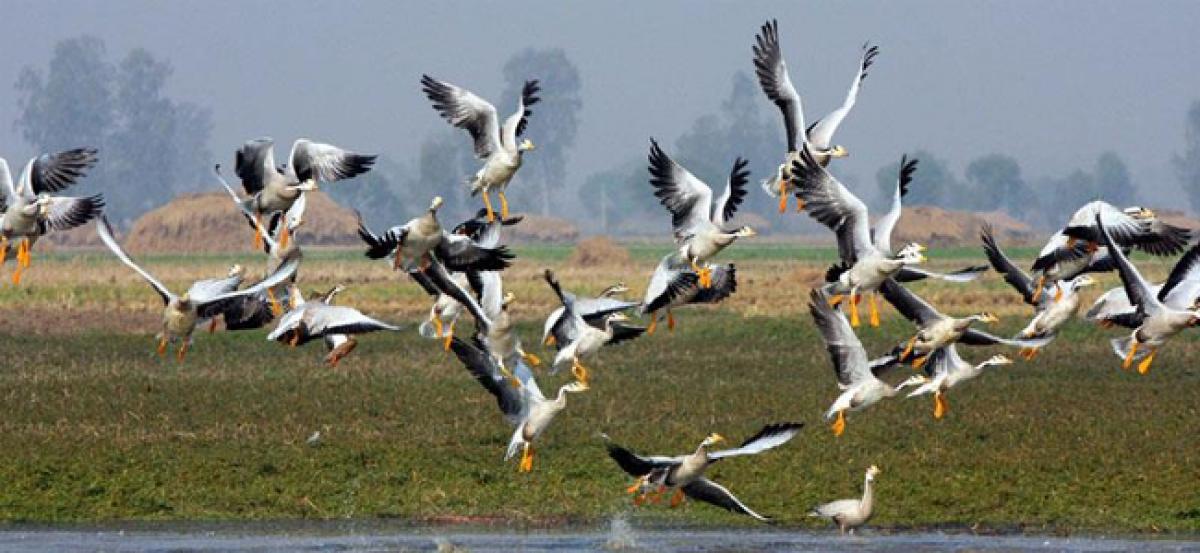Just In

Hundreds of migratory birds are bidding an early adieu to Kashmir this year because of unusually hot temperatures and scant rain and snowfall.
Srinagar: Hundreds of migratory birds are bidding an early adieu to Kashmir this year because of unusually hot temperatures and scant rain and snowfall.
"Normally, the migration back to summer homes from the Valley by the migratory bird species starts by the middle of March, but due to unusual rise in temperatures and scant precipitation during the winter months, these avian visitors are leaving earlier this year", said Imtiyaz Ahmad Lone, wildlife warden (Wetlands Kashmir).
Lone said many species of migratory birds including Pintails, Mallards, Pochards, Wigeons and Shovellers have already left the Valley for their summer homes in Russian Siberia, Eastern Europe, the Philippines, China, central Asia and other places.
The wildlife warden said last year 567,000 migratory birds including Greylag Geese, Mallards, Teals, Pochards, Wigeons, Shovellers, Gadwalls and Pintails came to spend the winter months in the bird sanctuaries and other water bodies of the Valley to ward off the extreme cold of their summer homes.
"This year, we fear the number of avian visitors would be much less," said Lone.
Srinagar city recorded a maximum of 20.4 degrees Celsius on February 24.
Sonam Lotus, director of the local MET office, said this had happened after 76 years.
For bird lovers and wildlife wardens like Lone, this is real bad news.
"There are multiple factors responsible for lesser number of birds visiting the Valley this year. The biggest of course is the climate change, but shrinking areas of our bird reserves, pollution of water bodies because of discharge of effluents contribute heavily to affect the health of our water bodies", said Lone.
In addition to the migratory bird species that live here permanently during the winter months, there are many species which come for a while.
"There are many birds of passage like the Cormorants and Sandhill cranes which spend some time in the Valley both in the beginning of the winter season and towards the end of this season," he said.
The birds of passage then move on to Indian plains spending some more time in the Valley on return journey to their summer homes.
"This year, due to early spring setting in the Valley, the birds of passage could very well overshoot our water bodies by deciding not to spend any time here at all", the warden said.
The Valley's best known bird sanctuaries are the Hokarsar on the outskirts of Srinagar city, Hygam and Mirgund in Baramulla district and Shallabugh in Ganderbal district.
"Very few Greylag Geese came to the Valley this year. The Geese need much bigger water spaces for feeding and spending time.
As water bodies shrank in the Valley this year, most of the migratory bird sanctuaries hosted fewer numbers of Geese this winter.
The Wullar Lake hosted comparatively better numbers of Geese this season, but nowhere like the flocks that have been seen in the past.
In unprotected water bodies like the Wullar Lake and many others, poachers are reportedly shooting the migratory birds as the local wildlife department is understaffed.
"We are taking all steps to check poaching outside the bird reserves and we have seized many weapons and lodged cases against poachers. There is absolutely no chance of any poaching in the protected water bodies," the warden said, adding that any poaching would be happening in unprotected water bodies.
Under the laws of the land, shooting of birds is an offence and a stringent punishment is prescribed for offenders.
Migratory birds are great navigators travelling thousands of miles between their summer and winter homes.
"The eldest in the flock leads during navigation as others fly behind in a highly disciplined pattern. If the leader falls sick or gets shot during the flight, the second in the lead takes immediate command," said Lone.
Different species of the birds fly separately and that is why the maxim, birds of the same feather fly together.
The cackle of the migratory birds, their wonderfully variegated plumage and the majesty of their flight are a legacy Kashmir cannot not allow to wither away.
Lone said water bodies not directly protected by the wildlife department fall under the control of other government agencies.
"It is the duty of these agencies to protect the migratory birds as they are an important aspect of the eco-system of water bodies", Lone asserted.

© 2024 Hyderabad Media House Limited/The Hans India. All rights reserved. Powered by hocalwire.com







